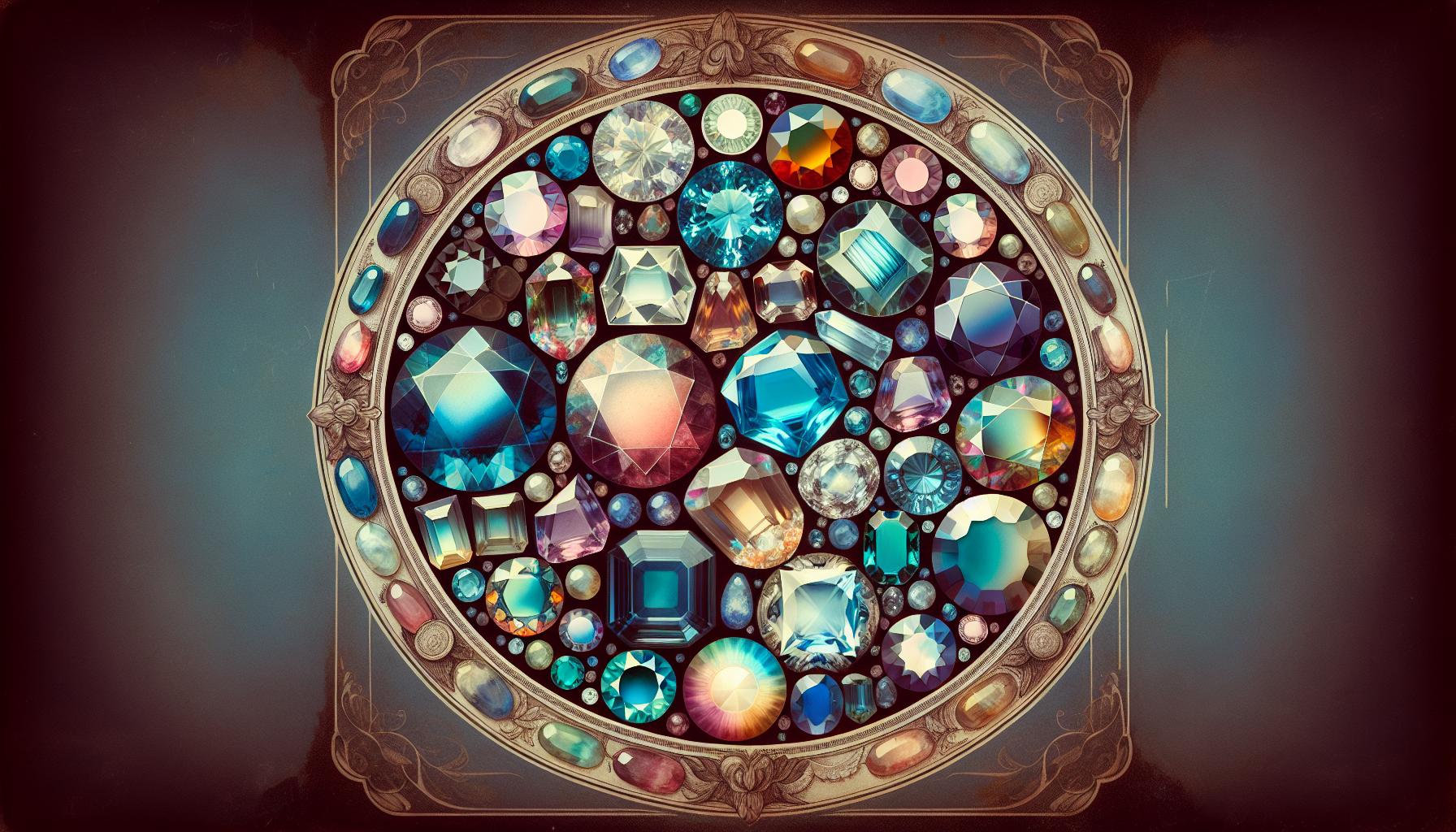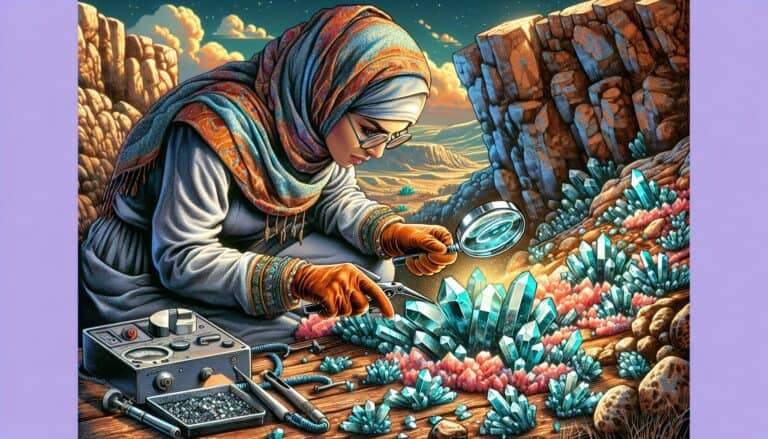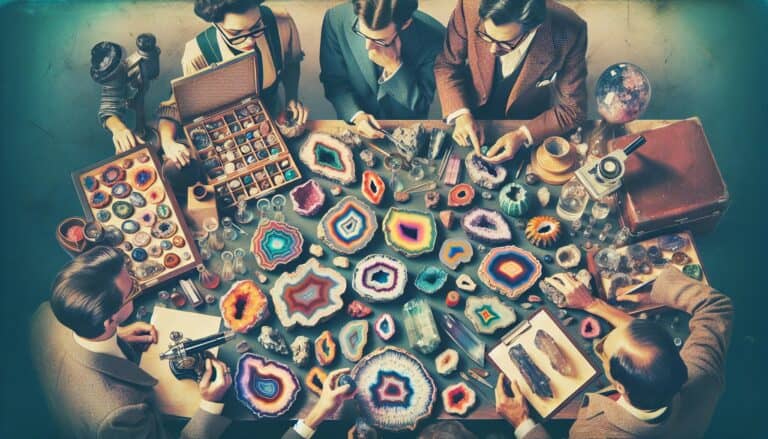You’re eyeing that serene blue chalcedony at your favorite jewelry store, and it’s calling your name.
But before you dive into your wallet, you’re probably wondering, “How much is chalcedony worth?” It’s a valid question, especially when you’re considering adding this gem to your collection.
Chalcedony’s value can be as layered as its quartz family roots, with prices that vary widely based on color, clarity, cut, and origin. Whether you’re in the market for a cabochon or a finely faceted jewel, understanding what affects chalcedony’s price is key to making a savvy purchase.
Let’s unravel the mystery behind the value of this captivating gemstone.
Chalcedony’s value is influenced by color, clarity, cut quality, and rarity. Vividly colored pieces like blue chalcedony are more prized. High clarity and skillful cuts increase value. Rare varieties, such as Botswana Blue, command higher prices. Market demand and limited availability due to unique formation conditions also affect pricing.
What Is Chalcedony?
Chalcedony is a captivating gemstone known for its translucence and its variety of colors. It’s a form of quartz, which means it’s composed of crystals so fine that they’re nearly impossible to distinguish even under a microscope. This gives the gemstone a waxy luster and a smooth, solid appearance that’s highly sought after in jewelry and ornamentation.
You’ll find that chalcedony comes in an array of colors from white, blue, red to multi-colored varieties. Blue chalcedony is especially popular due to its soft, serene hue that invokes a sense of calm. It’s this versatility in appearance that contributes to its wide use in various forms of jewelry including rings, earrings, bracelets, and necklaces.
The gemstone’s hardness on the Mohs scale is about a 6 to 7, making it durable enough for everyday wear. However, it’s still important to take care when handling your chalcedony jewelry to avoid scratches and damage, as with any other kind of gemstone.
When it comes to the chemistry behind chalcedony, it’s principally composed of silicon dioxide. It forms through a process of slow crystallization of silica-rich fluids within voids or in cavities of volcanic rocks or limestone. The conditions under which chalcedony forms greatly affect its final appearance and quality. Variations in temperature and pressure can result in differing transparencies and patterns, which in turn, influence the individuality and uniqueness of each stone.
An interesting fact about chalcedony is that it’s not only valued in the world of jewelry. Historically, it’s been used for cameo and intaglio engravings, and has held significant meaning in various cultures as it was believed to ward off negative energies and promote emotional balance.
As you explore the world of gemstones, remember that the allure of chalcedony goes beyond its physical appearance. It’s a stone that has captured human fascination for centuries, playing a role not just in fashion but also in the realms of history and culture.
Chalcedony Prices: Factors That Affect Value

Color, Clarity, and Cut Quality
When you’re looking to determine the value of a chalcedony gemstone, you’ll find that the interplay of color, clarity, and cut quality is fundamental. Vibrant colors like deep blues or striking greens tend to fetch higher prices. However, the value doesn’t hinge on color alone; the clarity of the stone is also vital. Gemstones with no visible inclusions or defects are prized for their pure appearance, thus boosting their worth.
The cut quality of chalcedony influences its overall appeal and, consequently, its value. Artisanal cuts that enhance the stone’s natural beauty without compromising its size are highly sought after. A well-executed cut that maximizes the gemstone’s luster can significantly increase its market price.
Market Demand and Availability
Market demand is a dynamic factor that can cause chalcedony prices to fluctuate. Certain colors of chalcedony, like the coveted blue chalcedony, often have a higher demand, impacting their sale price. It’s essential to be aware of current fashion trends and collector interests, as these can dramatically influence demand.
Availability also plays a crucial role in valuation. Chalcedony that is rare or sourced from unique locations often carries a premium. For instance, gems extracted from remote mines with distinct coloration or historical significance might be valued more for their uniqueness and the stories they carry.
Remember, while large quantities of common chalcedony may be readily available, high-quality pieces with exceptional characteristics are much tougher to come by, making them more valuable. Keep an eye on how these factors interact, as they will guide you in understanding the nuanced value of chalcedony gemstones.
Understanding Chalcedony: A Rare Gem

The Rarity of Chalcedony
When you’re exploring the world of gemstones, chalcedony’s rarity can add significantly to its allure and value. Unlike other more readily available stones, chalcedony’s presence in the market can fluctuate dramatically. The rarest forms of chalcedony are those with distinctive, vivid colors, which are not frequently found. Botswana Blue, for instance, is a unique type of blue chalcedony, which owes its remarkable color to the specific conditions of the region it is mined from. The scarcity of such specific hues can drive up the demand.
Additionally, certain varieties of chalcedony, like the coveted gem silica chrysocolla, are inherently scarce due to the unique geological conditions required for their formation. These rare varieties are typically found in just a few locations around the globe, contributing to their higher market value. Availability also plays a crucial role; some types of chalcedony are seasonal or intermittent in their mining, which can cause temporary spikes in their perceived rarity and value.
Origins and Characteristics
Chalcedony, part of the quartz family, owes its origins to a fascinating geological process. Often formed in volcanic areas, these gemstones are the product of silica-rich fluids oozing into cracks and cavities within the host rock, eventually solidifying into what you recognize as chalcedony. The conditions under which each stone forms is unique, giving rise to a mesmerizing array of patterns and colors.
Key characteristics that define the desirability and therefore the value of chalcedony gemstones include:
- Color: Ranges from translucent to opaque, with blue, pink, and green being particularly popular.
- Transparency: Higher levels of transparency often correlate with higher value.
- Luster: The more waxy and polished the appearance, the more appealing it is to buyers.
Understanding these origins and characteristics is crucial in appreciating why chalcedony’s worth is such a complex interplay between aesthetics and scarcity. Your grasp of what makes each stone special not only helps in making an informed purchase but also enriches your admiration for this rare gem.
Chalcedony Grading and Valuation
The Grading System for Chalcedony
When determining the value of chalcedony, understanding the grading system is crucial. Unlike diamonds that have a clear-cut grading system (the 4Cs), chalcedony is evaluated by factors such as color consistency, translucency, and size. Color is paramount; vivid and unique hues tend to fetch higher prices. The overall translucency of the stone can also be a significant factor, with more translucent chalcedony commanding greater value.
Another aspect impacting value is the presence or absence of inclusions, which are internal features or materials within the stone. Inclusions can either diminish or enhance value; for example, some collectors consider certain types of inclusion patterns, like agate banding, desirable.
- Criteria used in the chalcedony grading system include:
- Color: Uniformity and rarity
- Translucency: The degree to which light passes through
- Size and weight: Larger pieces often have a higher value
- Inclusions: Presence of desirable or undesirable internal features
- Workmanship: Quality of the cut and polish
The market also looks at the craftsmanship involved in cutting and polishing the gemstone. A well-crafted chalcedony will showcase its best features and can greatly increase its appeal to buyers.
Certification and Appraisal
For high-value chalcedony, certification and appraisal are important steps to authenticate and assess the gemstone’s worth. Certification from a reputable gemological laboratory provides a reliable document detailing the gemstone’s characteristics and confirming its authenticity. This can be critical when selling or insuring your gemstone.
During appraisal, an expert examines your chalcedony to determine its market value. Factors affecting this process include the current demand, the rarity of the specific type of chalcedony, and the gemstone’s overall condition.
- Key benefits of acquiring a certification and appraisal include:
- Validation of the gemstone’s characteristics
- Confidence in the chalcedony’s authenticity for buyers
- Accurate valuation for insurance purposes
When selecting a professional for certification or appraisal, ensure they are recognized and have a strong reputation in the industry. Credentials from associations like the American Gem Society (AGS) or the Gemological Institute of America (GIA) signal a level of trustworthiness and expertise that’s vital for accurate evaluation.
Current Market Trends in Chalcedony Pricing
The ever-evolving gemstone market directly impacts chalcedony pricing, and staying informed can help you make savvy purchasing or investment decisions. The price of chalcedony isn’t fixed; it fluctuates based on current market trends influenced by supply and demand, fashion trends, and economic factors. Recently, the market has seen a surge in demand for chalcedony, particularly from emerging markets with growing middle classes.
Popularity and Demand
Chalcedony has enjoyed a resurgence in popularity as designers and collectors seek unique and natural materials for their pieces. This increased desire often leads to higher prices for top-quality specimens. As a versatile stone, chalcedony’s range of colors and patterns fits well with contemporary style preferences, which emphasize organic, earthy aesthetics.
Impact of Global Economy
Similarly, the global economy plays a pivotal role in chalcedony’s value. Economic downturns might make high-end gemstones like chalcedony less accessible for the average consumer, while economic booms could see prices spiking due to increased disposable income and luxury spending.
Sourcing and Ethical Considerations
In recent years, ethical sourcing has become a notable trend affecting gemstone prices. Stones like chalcedony, which are ethically sourced, often command higher prices. This is a direct result of consumers’ growing awareness and their willingness to pay a premium for gemstones that are responsibly mined and traded.
Technological Advancements
Innovation in mining technology and gemstone treatment can also impact chalcedony pricing. Enhancements that improve the appearance of lower-quality chalcedony could make it more marketable, thus affecting the overall pricing landscape.
Tracking these market trends provides insight into the future trajectory of chalcedony prices. If you’re eyeing chalcedony for your collection or as an investment, it’s essential to keep a pulse on the market and consult with experts who can offer valuable analysis on potential price movements.
The Most Expensive Chalcedony
When exploring the echelons of high-end gemstones, you’ll notice that The Most Expensive Chalcedony can command staggering prices. Rarity fuels desire, and there are few examples that encapsulate this principle better than the illustrious gemstones known as gem silica or chalcedony chrysocolla. This vibrant, translucent blue-green variant is a cornerstone of chalcedony’s upper price bracket, often fetching upwards of thousands of dollars for pristine stones.
- Intense, vivid color saturation
- High degree of translucency
- Minimal inclusions
- Superior workmanship
- Size and weight of the stone
Particularly notable are the gem-quality pieces from coveted locales like the Inspiration Mine in Arizona. These have been known to set the market alight with their desirability. Origins play a crucial role in value determination – stones with a verifiable provenance from such renowned mines generally attract premium prices.
Chalcedony’s appeal is not limited by geography. Collectors and connoisseurs worldwide chase select pieces distinguished by their exceptional characteristics. It’s essential to understand that while two stones may appear similar, subtle differences in hue, clarity, or even cut can make a profound impact on their valuation.
| Element | Impact on Value |
|---|---|
| Color | Direct correlation |
| Clarity | Higher clarity, higher value |
| Cut | Precision enhances worth |
The craftsmanship involved in bringing out the best in this gemstone cannot be understated. Artisanal cutters who can enhance the inherent beauty of high-quality chalcedony contribute significantly to their worth. Their expertise in creating captivating shapes and facets enables the full potential of the stone to be realized.
For those seeking to own a piece of this luxury, the market is always shifting. Your awareness of factors that spike chalcedony’s value and your attentiveness to market trends serve as your guide in identifying pieces that are not just beautiful but also a potential investment. The stories these gemstones carry and the hands through which they’ve passed add layers of intangible value that fascinate and draw in high-end buyers and collectors.
Buying Chalcedony: Tips and Recommendations
When you’re venturing into the mesmerizing world of gemstones, purchasing chalcedony can be an exquisite addition to your collection. Yet, navigating the market to find a piece that claims true value requires know-how. Here’s what you should consider.
Where to Purchase High-Quality Chalcedony
Gemstone Speciality Stores: For a hands-on experience, visit stores that specialize in gemstones. Staff in such outlets often have extensive knowledge about chalcedony and can provide valuable insights.
- Gem Shows: These events showcase a wide array of chalcedony pieces from numerous vendors. They’re an ideal spot for comparing different stones and prices.
- Online Marketplaces: Reputable online retailers have expanded the accessibility of chalcedony. Look for sellers with high ratings and positive reviews.
- Local Jewelers: Some local jewelers offer high-quality gems. They may also provide customization options to enhance the beauty of your chalcedony.
- Direct from Miners or Lapidaries: To get as close to the source as possible, consider purchasing directly from those who mine or cut the stones. This can often lead to better prices and authenticity.
Be wary of deals that seem too good to be true, as these may be indicative of lower-quality stones or even counterfeits. Verified and ethical sources should always be your first choice.
Ensuring Authenticity and Value
Certification and Appraisal: Only buy chalcedony that comes with certification from a reputable gemological lab. Appraisals should be done by accredited professionals who can provide an accurate valuation of your gemstone.
- Understanding Grading: Familiarize yourself with the grading system for chalcedony. Knowing the factors that contribute to its grade will help you judge if a piece is worth its price.
- Check for Treatments: Some chalcedony may be treated to enhance its color or clarity. Disclosure of such treatments is mandatory and affects the stone’s value.
- Refund and Return Policies: Ensure you understand a seller’s return policy. A flexible policy is often a sign of a seller’s confidence in the quality of their stones.
Keeping yourself educated on current market trends and knowing where and how to purchase can greatly influence the satisfaction and returns of your chalcedony investment. Remember, transparency from the seller about the stone’s attributes and history is paramount in determining its true worth.
Conclusion: Buying & Selling Chalcedony
Determining the true worth of chalcedony isn’t just about its price tag—it’s about understanding the unique factors that contribute to its value. Armed with knowledge about its rarity, origins, and characteristics, you’re well-equipped to make informed decisions when purchasing this gemstone.
Remember to prioritize authenticity and quality by shopping at reputable sources and insisting on certification. Stay educated on market trends and always seek transparency regarding a stone’s attributes and history.
By doing so, you’ll ensure that you’re investing in a piece of chalcedony that truly reflects its worth.







